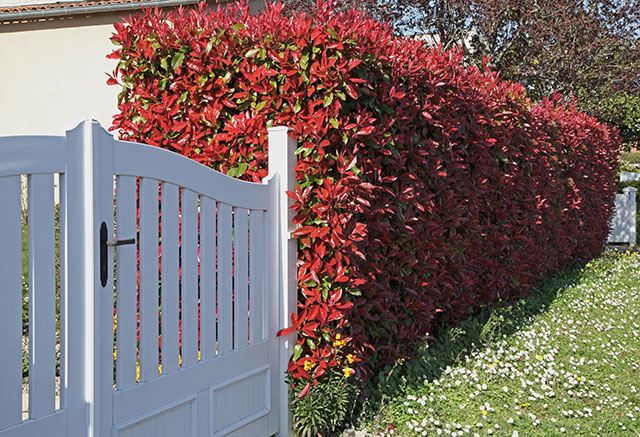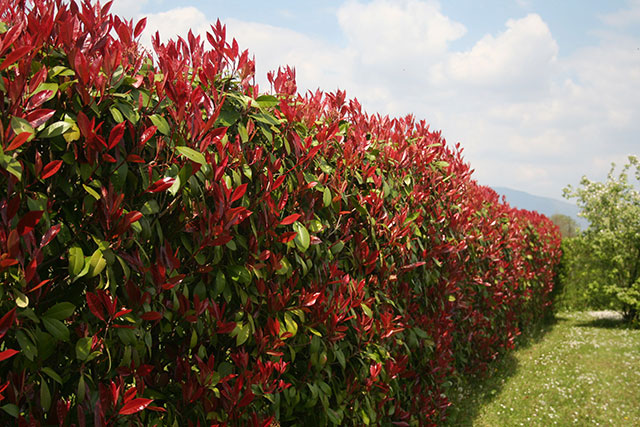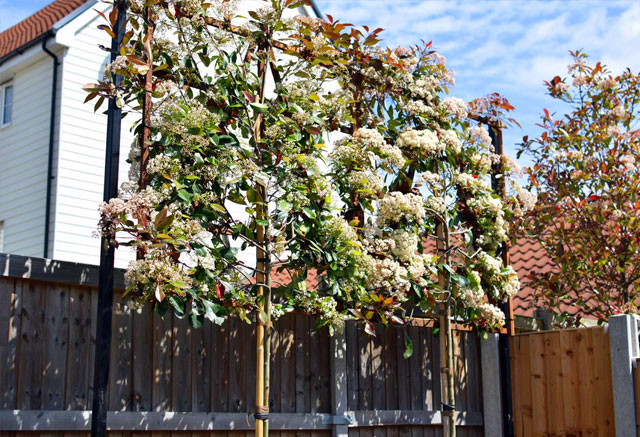Photinia Red Robin hedge plants, also known as Photinia x fraseri 'Red Robin' is a stunning evergreen hedging species that provides seasonal interest and is perfect for formal hedges.
Choose from our most popular varieties of Photinia Hedging plants, available in a range of sizes and root types.
Photinia Red Robin is a stunning evergreen hedging plant with glossy green leaves that are brilliant red when young.
Growth rate: Medium 20-40cm per year
Overall height: Tall up to 7.5 metres
Position: Sheltered, Full Sun, Exposed
Root Types: Instant Hedging, Pot Grown
To learn more about Photinia Hedging, take a look at our helpful Hedging Guides & FAQ's
Our team are on hand to help answer your questions!
info@hedgingplantsdirect.co.uk
Opening times
Monday - Friday : 7:30am - 4:30pm
Saturday & Sunday: 10am - 2pm
We are also open 10am to 2pm on bank holidays
Imagine a vibrant, eye-catching red robin hedge that not only enhances the aesthetic appeal of your garden but also attracts a diverse array of wildlife. Photinia Red Robin is a versatile and stunning hedging plant that can transform any outdoor space. In this guide, we delve into the unique features of the Photinia Red Robin, planting and care tips, and creative landscaping ideas to inspire your garden design with a red robin hedge.

Photinia Red Robin, a dense evergreen shrub, boasts an alluring combination of glossy, dark green leaves that turn bright red, creating a striking visual contrast in any garden setting. This hedging plant is not only pleasing to the eye, but also provides a beneficial windbreak and adds texture to your garden.
Moreover, the vivid red foliage and open growth of Photinia Red Robin hedges make them attractive to birds and other wildlife, creating a harmonious relationship between nature and your garden.
Photinia Red Robin's most notable features are its bright red, glossy new foliage and loose growth, allowing movement in the wind. This unstructured form sets it apart from other common hedges, giving your garden a distinct and captivating appearance.
The average growth rate of a Photinia Red Robin hedge is approximately 30 cm annually, making it a suitable choice for gardeners who desire a moderate growth rate that can be easily maintained. To achieve the most vivid red color, plant your Photinia Red Robin in a sunny spot in a location with ample sunlight.
Photinia Red Robin's small, creamy-white flowers in early spring and berries later in the season serve as a magnet for various birds, such as blackbirds, fieldfare, starlings, and redwings, who relish the berries the plant produces. The rustling of the branches in the wind also creates a distinctive sound that draws wildlife to the hedge, further enriching the ecosystem of your garden.
By incorporating Photinia Red Robin into your garden design, you create a haven for wildlife while also enjoying the visual and auditory pleasures it offers.
Planting your own Photinia hedging or Red Robin hedge is a straightforward process when you follow the right steps.
This guide will provide you with essential information on choosing the perfect location, preparing the soil, and employing the proper planting techniques to ensure the healthy growth and development of your photinia hedging hedge.
The recommended spacing for planting Photinia Red Robin as a hedge is between 60 cm/2 ft and 90 cm/3 ft apart.
With the help of hedge planting fertilisers such as RootGrow, you can further the planting distances to improve the growth and establishment of your Photinia Red Robin hedge.

The optimal conditions for planting Photinia Red Robin involve full sun to partial shade, well-drained soil, and slightly acidic soil. It's essential to consider the available space for the plant's growth, as overcrowding can lead to poor growth and increased susceptibility to diseases.
Remember, to achieve the most vibrant red foliage, planting Photinia Red Robin in a location with ample sunlight is crucial.
Before planting your Photinia Red Robin, it's essential to ensure that the soil is adequately drained yet moist. Incorporate garden compost or well-rotted manure to enhance the soil conditions prior to planting. Adding a well-balanced organic fertilizer or compost to the soil will improve the nutrient content and support the overall health and growth of your Photinia Red Robin.
During the growing season, it's recommended to nourish the soil once every 4 to 6 weeks with our granular Hedge Feed
To plant your Photinia Red Robin, first dig a hole twice as wide as the pot or root ball and the same depth. Mix in compost or other organic matter to improve drainage and soil quality. Gently remove the plant from the pot and place it in the hole, then fill the hole with soil and press down firmly.
Finally, water the plant thoroughly to ensure proper establishment. It's crucial to follow the recommended spacing guidelines of 60 cm/2 ft to 90 cm/3 ft apart for young plants for optimal growth and hedge density.
Planting your own Photinia hedging or Red Robin hedge is a straightforward process when you follow the right steps.
This guide will provide you with essential information on choosing the perfect location, preparing the soil, and employing the proper planting techniques to ensure the healthy growth and development of your photinia hedging hedge.
Caring for your Photinia Red Robin hedge is a manageable task when you understand the essential steps involved. This guide will cover the crucial aspects of caring for your hedge, including pruning and shaping, watering and fertilising, and pest and disease control.
With proper care, your Photinia Red Robin hedge will thrive, providing you with a visually stunning and functional addition to your garden.

The optimal time to prune your Photinia Red Robin hedge is in the spring and/or summer. Pruning once or twice per year will help maintain its desired size and tidiness, while also promoting new growth.
When pruning, we recommend trimming the shoots and new branches by 10-18 cm, and only remove approximately one-third of the total foliage at a time. It's important to avoid pruning during the wet season, as this can increase the risk of diseases and damage to the plant.
Water your Photinia Red Robin regularly during the first two years after planting, and only during severe, prolonged drought once the plant is established.
Fertilisation is not essential, but it can enhance the growth and overall health of young plants in your hedge. It's advisable to use a granular 7-7-7 hedge feed once a month from late spring to September.
In order to effectively manage pests and diseases on your Photinia Red Robin, it's important to inspect the plant regularly for signs of damage or infestation, such as discolored new leaves or wilting.
Some natural methods for controlling pests and diseases include removing diseased leaves and branches, using organic fungicides such as Bordeaux mixture, and applying a thick mulch around the plant. Chemical control methods are also available, employing fungicides specific to the disease affecting the root system of your hedge.
For further information please see our comprehensive guide on how to identify and resolve common problems with Photinia hedges.
In addition to its many practical benefits, Photinia Red Robin offers a wealth of creative landscaping possibilities. By incorporating this versatile plant into your garden design, you can create stunning privacy screens, mix it with other plants for visual interest, and even add vertical interest to your outdoor space.
Let's explore some of these innovative ideas and discover the potential of Photinia Red Robin in your garden.
Photinia Red Robin is an ideal plant for constructing privacy screens, thanks to its large red leaves that form a great barrier and soundproofing agent. To construct a hedge, individual plants should be spaced at approximately 75 cm for a fast-growing, dense hedge.
When hedging is grown against a wall or fence, the plants should be at least 60 cm away from the wall or fence to ensure proper growth and establishment. With the right planting techniques, your Photinia Red Robin hedge can provide both privacy and a beautiful visual backdrop for your garden.
Combining Photinia Red Robin with other plants can result in a visually appealing and distinctive garden. Suitable companion plants for Photinia hedges include large deciduous shrubs, ornamental grasses, lavender, and spring bulbs. Plant these companions in a single row between 60 cm/2 ft and 90 cm/3 ft apart to create a harmonious and eye-catching garden design.
Mixing Photinia Red Robin with other plants not only provides additional texture, color, and visual depth to your garden, but also supports a diverse ecosystem for various wildlife.
Incorporating vertical interest with Photinia Red Robin involves utilising the plant to construct a hedge or screen that provides height and texture to your garden.
Planting in a staggered pattern, using multiple plants to form a hedge, and pruning to generate a desired shape pot size are effective methods for achieving this goal.
The most common way of achieving vertical interest quickly, is to use Pleached Photinia Red Robin, designed to be planted next to a fence or wall, these beautiful hedges on a frame provide both privacy and can act as a noise screen.
Creating vertical interest with Photinia Red Robin not only establishes a visual barrier and privacy, but also introduces texture and colour to your garden, making it a truly captivating outdoor space.

In conclusion, Photinia Red Robin is a versatile and stunning hedging plant that can transform any garden into a visually striking and wildlife-friendly haven. Through understanding the unique features of Photinia Red Robin, proper planting and care techniques, and exploring creative landscaping ideas, you can create a garden that is not only beautiful but also functional and environmentally conscious. Take the first step towards designing your dream garden with Photinia Red Robin and experience the captivating allure of this remarkable plant.
Red Robin hedges are an excellent choice for creating fast-growing, dense coverage. In ideal soil conditions, Red Robin can grow 30 cm per year to give a full appearance and provide quick coverage.
It also has attractive red foliage during the spring and summer months, making it a popular ornamental shrub for garden conditions. Therefore, it is safe to say that Red Robin is a fast growing hedge.
For gardeners looking for an attractive, formal hedge, Photinia x fraseri 'Red Robin' is the perfect solution. Its strong evergreen growth responds well to trimming and its bright red new shoots give this hedge a vibrant look that is sure to add interest to any outdoor space.
For a Red Robin Photinia hedge, it is recommended to plant the shrubs at 2 plants per metre with a spacing of 50cm (or about 2ft) between each plant. This spacing should provide an ideal balance between allowing enough room for each plant to grow, while also ensuring the hedge will fill in quickly and form a solid wall of greenery.
To ensure the hedge grows in evenly, it is important to plant the shrubs in a straight line. This will help to create a neat and uniform look. Additionally, it is important to water the plants regularly and to prune them back in the spring to encourage new growth.
Red Robin hedges can grow up to 7 meters in height and 3 meters in width, making them a substantial and striking presence in any garden. With proper care and maintenance, these hedges can be kept under control by pruning twice a year.
New shoots should also be trimmed to encourage bright red re-growth for a stunning display of foliage.
When planted next to Photinia Red Robin, shrubs with colorful foliage such as the spiky Mahonia or exotic-looking Fatsia japonica are perfect accompaniments to red berries. To add texture and visual interest in winter, consider planting other deciduous trees or shrubs such as Dogwood or Viburnum.
Combining these plants and trees creates an interesting and visually pleasing landscape.